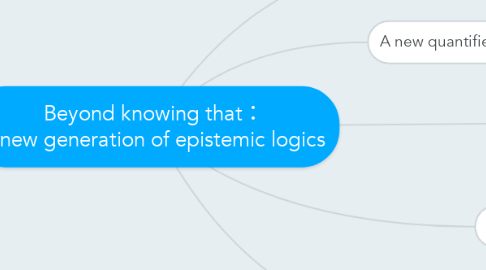
1. Introduction
1.1. Standard epistemic logic of "knowing that"
1.2. Knowing-wh is also interesting
1.2.1. Statistics from Google
1.2.2. From the perspectives of other fields
1.2.2.1. Linguistics
1.2.2.1.1. classification of verbs
1.2.2.2. Philosophy
1.2.2.2.1. comparing different types of knowledge
1.2.2.3. AI
1.2.2.3.1. specification of goals and preconditions of actions
1.2.3. Epistemic Logic
1.2.3.1. quantifying into modal scope caused conceptual and technical troubles
1.2.3.2. not so much has been said in textbooks and handbooks
1.3. Structure of the paper
2. History
2.1. Hintikka on knowing-wh
2.1.1. epistemic logic can be applied to understand questions
2.1.1.1. "knowing who b is" the goal of the question "who is b"
2.1.1.2. knowing acquisition is more important than knowledge justification
2.1.2. formalizing knowing-wh requires quantifiers
2.1.2.1. distinction between de re and de dicto
2.1.2.2. need to draw worldlines
2.1.2.2.1. visual
2.1.2.2.2. descriptive
2.1.2.3. different worldlines induce different meanings of knowing-wh
2.1.3. conclusiveness condition
2.1.3.1. knowing that b murdered c does not entail knowing who murdered c
2.1.3.2. you also need to know who b is
2.1.4. knowing-wh may require higher-order entities
2.1.4.1. explain the role of mathematical knowledge in empirical sciences
2.1.5. independent friendly techniques may avoid higher-order quantifiers
2.2. Technical advances of quantified epistemic logic
2.2.1. a survey by Gochet and Griboment
2.2.2. application-driven advances
2.2.2.1. security
2.2.2.2. game theory
2.2.2.3. monodic fragments
2.2.2.4. FO epistemic temporal logic
2.2.3. quantifying over agents
2.2.4. quantifying over propositions
2.2.5. inquisitive epistemic logic
3. A new quantifier-free proposal
3.1. pack quantifiers and modalities together into new modalities
3.2. advantages
3.2.1. neat language
3.2.2. intuitive axioms
3.2.3. balancing expressivity and complexity
3.2.4. avoiding conceptual problems
3.2.5. connections to existing modal logics
3.3. limitations and difficulties
3.3.1. not fully compositional
3.3.2. no context sensitivity
3.3.3. weak language and rich semantics
3.3.4. non-normal modal logics
3.3.5. diversity in different knowing-wh
3.3.6. sometimes no available semantics
4. Examples
4.1. Knowing whether
4.1.1. background
4.1.1.1. succinctness and usefulness
4.1.1.2. non-contingency logic
4.1.2. language, semantics and expressivity
4.1.2.1. almost-definability
4.1.2.2. delta-bisimulation
4.1.2.3. undefinability of frame properties
4.1.3. axiomatization
4.1.3.1. canonical model construction
4.1.3.1.1. construct two successors to negate knowing whether
4.1.3.2. axioms for different frame classes
4.1.3.3. adding the announcement operator
4.2. Knowing what
4.2.1. background
4.2.1.1. Plaza's work on Kv operator
4.2.1.2. No reduction axioms
4.2.2. language, semantics and expressivity
4.2.2.1. conditional Kv operator
4.2.2.2. FO-epistemic models with a constant domain
4.2.2.3. EL with conditional Kv is equally expressive as PAL with standard Kv
4.2.3. axiomatization
4.2.3.1. maximal consistent sets are not enough in canonical model
4.2.3.1.1. we need counterparts of the potential sub formulas
4.2.3.1.2. need to saturate each MCS with those counterparts
4.2.3.2. reduction axioms for the announcement operator
4.2.3.3. PSPACE complexity
4.2.4. simplification of the semantics
4.2.4.1. take the negation of Kv as a modality
4.2.4.2. introducing the ternary relation instead of the value assignment
4.2.4.3. three frame properties
4.2.4.4. the new semantics keeps the same logic
4.2.4.5. extending the language with a binary modality
4.2.4.5.1. still equally expressive
4.2.4.5.2. has a normal modal logic system
4.2.5. new dynamic operator
4.2.5.1. announcing the value
4.2.5.2. connections to dependence logic and inquisitive epistemic logic
4.3. Knowing how
4.3.1. background
4.3.1.1. philosophy
4.3.1.1.1. implicit conditions
4.3.1.2. AI
4.3.1.2.1. conformant planning
4.3.1.3. clarifications
4.3.1.3.1. goal-directed
4.3.1.3.2. not degree of emotions
4.3.2. language and semantics
4.3.2.1. binary modality
4.3.2.2. semantics inspired by planning
4.3.3. axiomatization
4.3.3.1. building two successors in canonical models is not enough
4.3.3.2. the use of U in the axiomatization
